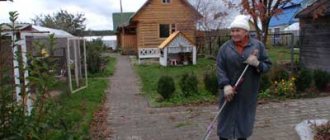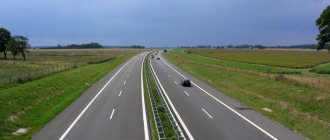What it is?
A person or organization that has the right to use a land share for agricultural purposes may dispose of it through the following actions :
- Sales to both the state and private individuals;
- Registration of a deed of gift for any individual. or legal face;
- Identification of the territory in its natural expression.
In the process of the need to formalize any transactions, the owner will in any case be faced with land surveying.
The delineation of a land plot that has a strictly agricultural purpose consists of carrying out a procedure for establishing the boundaries of the turning points of the land plot, after which lines are drawn between them defining the boundaries, which become the boundaries of the allotment.
The rules of law determine the possibility of allocating a share from common agricultural lands, in the process of which
a decision of a body having the appropriate powers will be required
for approval of the possibility of both carrying out the process and allocating a plot to make it the property of one of the shareholders.
The initiator, that is, the person who will take upon himself to organize the meeting and notify all interested parties, can be the following person or interested body :
- Participant in shared ownership of an agricultural share;
- Those persons who use the share for its intended purpose have the legal right to such action;
- The authority relating to the territory on which the land plot is located.
The initiator publishes an advertisement that must contain the following information :
- Meeting date;
- Issues that will be considered on the agenda;
- A place where you can review the documentation that will be drawn up on the basis of the meeting;
Such notification must be made no later than 40 days before the meeting.
The following issues may be considered at the meeting :
- Consideration of the possibility of preparing a land surveying project;
- Concluding an agreement with a cadastral engineer;
- Establishment of prices that will be acceptable when carrying out cadastral work;
- Determination of the shares of each participant.
In addition, one of the important issues is resolved at the meeting - who will be empowered to act on behalf of all members during the boundary approval procedure.
Land survey plan
In order to carry out land surveying, the company enters into a contract agreement with a cadastre engineer, defining the scope of work and agreeing on the price by drawing up an estimate. Based on the results of the activities carried out, a draft boundary plan is prepared.
The document consists of two parts:
- graphic, where the boundaries of the plot are determined and access to it is indicated (paths, paths for vehicle access, etc.);
- text, indicating that the work was carried out using state geodetic networks or support boundary lines, etc.
Boundaries are determined by setting the coordinates of characteristic points. The area of the plot is a geometric figure obtained by projecting the boundaries of the plot onto a horizontal surface. To clarify the perimeter, data is taken from documents establishing the right to land ownership, or information from an approved project for land surveying. If neither one nor the other is available, the outlines formed over the past fifteen or more years will be used as the basis.
The cadastral engineer provides each participant with the opportunity to familiarize themselves with the project before its approval. This must happen no less than 30 days before the general meeting. The place and regulations for familiarization are contained in the notices that the engineer sends to members of the organization or publishes in the media.
We recommend that you read:
Land surveying in SNT
The notice contains the following:
- who is the customer and the contractor, their location and contacts;
- cadastral number and location of the original plots;
- where, when and how acquaintance with the project can take place.
If there are objections to the passage of borders, the person who expressed disagreement provides the cadastre engineer with a written justification for the reasons for this, indicating the passport details and attaching copies of papers confirming ownership of the land.
Why is land surveying necessary?
In order to register a real estate property - land, dacha, garden plot, residential building, dacha, garage, apartment - with the state cadastral register, a land surveying procedure is required. Land surveying is work to establish on the ground municipalities and other administrative-territorial entities, the boundaries of land plots, securing such boundaries with boundary signs and determining coordinates.
Only registered land plots are subject to land surveying. Leased land cannot be demarcated.
The procedure is mandatory for the following types of land:
- Transferred for permanent use from state reserves;
- Subject to distribution due to various circumstances;
- Requiring division, consolidation or allocation of a share.
I don’t want to burden you with the technical side of the process. I will not go deeper into the legislative basis of land relations. If interested, read: Land Code, Federal Law No. N 221-FZ “On the State Real Estate Cadastre” (which regulates the procedure for land surveying), as well as the new law “On Amendments to the Land Code of the Russian Federation” dated June 23, 2014 No. 171-FZ - which simplifies the procedure for legitimizing garden plots, carried out in accordance with land surveying free of charge under the dacha amnesty from June 1, 2015, valid until December 31, 2020.
Please note that according to the actual amendments, the provision of paragraph 1 of Art. 19 (Federal Law “On State Registration of Real Estate” dated July 13, 2015 N 218-FZ July 2021) - citizens have the right not to survey their own land plots for sale, purchase or inheritance until the beginning of 2021. After this date, the procedure will become mandatory.
Selling Features
The purchase and sale of shares is similar to a gift agreement, the only difference is that a different package of documents is required. There may be many options for the required set of documentation, and registration procedures may also differ significantly.
Regardless of the reasons for which the land became part of the authorized capital, the re-registration procedure will be as follows:
- A decision is made to include land in the authorized capital.
- The land is valued by an independent appraiser.
- Documentation is being prepared.
- Constituent documents are registered.
- The transfer of land rights is registered.
- Other actions, depending on the specifics of the transaction.
There are two types of donation:
- the owner draws up a deed of gift for a close relative;
- the owner makes a gift to a distant relative or stranger.
The gift deed must be registered as required by law and the new owner must submit information about the transaction to the government agency.
If you decide to make a deal on your own, then this step is quite risky. It is better not to neglect the services of experienced lawyers in this case, since they deal with these issues constantly and are aware of all changes in laws, if any. A specialist in this matter will help not only set the correct price, but will also regulate the transaction process itself, make sure that the notice of sale is received by the appropriate authorities, and that all aspects are implemented legally.
Before selling the share, it is important to highlight it as a separate land object, having properly registered it. In addition, this property should not be encumbered with anything, including long-term rent. It is also important to make sure that the area of the agricultural territory does not exceed the maximum permissible size approved by the regional act
It is also important to make sure that the area of the agricultural territory does not exceed the maximum permissible size approved by the regional act
Of course, we cannot forget about taxation. Since the sale of an agricultural share is considered a profit, the seller is obliged to pay part of the amount to the state on terms similar to a lease. An exception can only be if the profit received does not exceed 5,000 times the minimum wage of a Russian citizen.
Since 1991, as part of the legislative initiative on the reorganization of state and collective farms, a significant part of the population of our country has had the opportunity to receive shares in agricultural land. The Federal Law regulating the turnover of agricultural land, in force since 2002, defines land shares as certain parts of a privatized plot.
Features of land surveying for agricultural purposes (shares)
Despite the fact that agricultural lands are not intended for the construction of permanent buildings, they also need land surveying.
After all, they are used to solve commercial problems, are fertile, and accordingly are also in great demand among buyers. It is the division of plots into shares that takes place among agricultural lands used for dachas, vegetable gardens and orchards. And these plots are managed by the corresponding SNT. In this regard, land surveying can be carried out both at the initiative of the partnership and the owner himself.
The owner will need to carry out boundary work in the following cases:
- When allocating his share of the plot, which he uses for its intended purpose.
- If he wanted to purchase the territory adjacent to his plot.
- When there are additions of land that can be registered as ownerless, and then as your property.
That is, when a citizen wants to gain independence and separate from the bulk of the land in a dacha cooperative.
In all other situations, land surveying is carried out on the initiative of a legal entity - the founder of SNT. That is, boundary work is carried out in relation to the entire tract of agricultural land related to a specific partnership.
And then the owners of each of their plots decide where the boundaries between their plots are and resolve disputes on this matter, if any arise.
To do this, either the owner himself or SNT can submit an application to a geodetic company, which will carry out boundary work and issue a ready-made document on the new boundaries - a boundary plan. If a specific individual owner is interested in land surveying, he must also submit in the package of documents consent from the SNT board to carry out cadastral work to clarify the boundaries of his plot.
Allocation procedure
The procedure for allocating a share occurs in several stages, each of which must be implemented in compliance with the requirements of current legislation. First of all, the initiator needs to coordinate his intention with other owners or the agricultural organization that owns the land and draw up a project. After this, it will be necessary to establish the boundaries of the site, that is, to carry out land surveying. Finally, the share plan must be approved by an authorized authority.
Coordination
The approval procedure depends on who is the owner of the land. If this is an agricultural organization, then you will need to send the application to the manager, who will review it and make his decision. When the territory is owned by several persons, a general meeting will be required.
In any case, relevant information must first be published in local media. That is, other applicants or owners are notified of the date, time and place of the meeting, as well as the issues that will be brought up for discussion.
People should also be informed about the location and procedure for reviewing the documentation that will be used during the meeting. The result of the discussion must be documented and communicated to all interested parties.
Surveying
The next stage in allocating a share is land surveying. Essentially, this is the determination of the boundaries of the site. To implement this stage, the initiator can contact a design organization that has a license to provide services of this nature. For these purposes, it will be necessary to conclude an agreement.
It states:
- Date and place of signing.
- Information about the parties.
- The subject of the contract, that is, the list of services that will be provided to the customer.
- Transaction cost and payment procedure.
- Rights, obligations and responsibilities of the parties.
- Contract time.
- Dispute resolution procedure.
- Bank details and signatures of the parties.
After this, the engineer from the design organization goes to the work site and collects the necessary information. For these purposes, photo and video recording of data is allowed. Then the responsible executor draws up a boundary plan of the site and transfers it to the customer. Then the latter makes a settlement with the contractor. At the end, the parties sign a certificate of completion of work.
Plan approval
The land survey plan must be approved. This is within the competence of the general meeting of other owners. During such an event, the correctness of determining the boundaries of the land plot is established. After this, a decision is made. It is drawn up in the form of a protocol.
Making a decision about allocation
The decision to allocate a land share is made by the owner of the territory. In practice, this could be any agricultural organization that owns land. Also, the decision can be made by other owners if the land is common, and the person intends to allocate a separate plot for himself. To do this, a meeting is held at which the issue is discussed. The final decision is made by a majority vote. The results are documented in a protocol. Such a document will be the starting point for the further implementation of the procedure.
Agricultural land
Current legislation establishes a list of types of agricultural activities that can be carried out on the site.
It includes:
- Conducting agriculture on an industrial scale.
- Planting special plantings in order to protect the territory from drought, retain snow, and blow away fertile soil.
- Ecological and agricultural tourism.
- Research and survey work.
- Breeding animals.
- Educational activities.
- Organization of peasant farming and subsidiary farming.
- Gardening and horticulture.
- Production of agricultural products, their warehousing and storage, as well as the construction of buildings necessary for this.
At the same time, individual housing construction in these territories is prohibited. If a plot of land is not used by a person for its intended purpose for three years, it can be seized in court.
The concept of land share
A land share is a part of the general territory.
It is allocated to the interested person based on the submitted application. It should be noted that the share can only be used for the intended purpose of the entire land. Most often, people receive individual plots for farming from an agricultural organization that is the owner of the territory.
Goals of agricultural land surveying
The need to survey such areas arises in the following situations :
- Coordination of boundaries to clarify the location of the boundary and approve it with government officials and neighbors;
- Restoring boundaries that were established earlier, but data on them was lost;
- Registration of ownership of the plot;
- Carrying out a civil transaction, which consists of selling a plot, exchanging it, leasing it;
- The need to resolve controversial issues that arise during the exploitation of land;
- Dividing one plot into two or more (delimitation) or combining several plots into one.
In what cases might it be necessary?
There are three most common cases when it may be necessary to change boundaries:
- In case of cadastral error. Then the geodetic company that made a similar error in the documentation carries out the land surveying work again and draws up a new cadastral plan with changed land boundaries.
- At the initiative of the owner. When one plot is divided into several, as well as when two or more plots are combined into one. And in this case, it will be necessary to carry out boundary work again.
- When clarifying the boundaries of the land plot. The owner resorts to the procedure for changing the boundaries of a plot of land if, when clarifying the boundaries, it turns out that the actual area of the plot differs significantly from that indicated in the documents. To avoid having to register a change in the boundaries of the site, the deviation in area cannot be more than 10%. If this indicator is exceeded, the owner has no choice but to change the boundaries of the land plot.
How is the land survey day going?
As a rule, on the day of surveying, a call is received from a specialist from a geodetic company notifying him of a visit to the site. They inform both the customer and neighbors. We will return to the issue of informing neighbors before land surveying.
So, upon arrival at the site, the cadastral engineer or his assistant:
- Will make a general measurement of the land plot;
- Determines the coordinates of boundary markers;
- Determine the boundaries, coordinate them with adjacent land users and document the agreement (act of land survey approval). If there are no complaints, the on-site surveying procedure is completed.
As a rule, land surveying takes place autonomously (without your participation). If you want to participate, plan to spend 1-2 hours on the day of surveying.
What lands are subject to surveying?
Not all territories are subject to measurements and subsequent divisions. These include the following:
- lands allocated for the development of agriculture (planting, farming. Forest areas can also be allocated for this purpose);
- residential areas (villages, towns, cities);
- state or municipal plots of land that are considered reserve;
- natural and economic objects that are state property (forest, water resources);
- tourist and recreational areas.
If an area is intended for one type of exploitation, but is used for another type of exploitation, a fine may be imposed on the violator.
Let's say it is prohibited to use lands belonging to the forest fund for the purpose of walking livestock.
Land surveying of agricultural lands in the Guild of Engineers
Agricultural land surveying work
, owned by one person and carried out by specialists of our company, include:
- preliminary measures to collect the necessary cartographic, legal and geodetic materials for the site;
- field survey to assess the condition of reference boundary markers (RBS): the state geodetic network and the reference boundary network;
- determining the boundaries of the land plot that is planned to be demarcated;
- preparation by a cadastral engineer of a boundary plan for the site;
- notification of other persons whose rights may be affected in the process of land surveying about the carrying out of these works here, with subsequent approval and consolidation of boundary boundaries;
- registration of this Boundary Plan with the body carrying out state cadastral registration.
Our company offers you a full range of work on agricultural land surveying
, including the restoration of boundary signs, determination of the boundaries of the boundary area and legal registration of land rights. A well-established organization of all work and a staff of qualified specialists allow us to carry out boundary work efficiently, competently and in the shortest possible time. For more detailed information, please call our company.
Content
Let's consider the contents of the boundary plan based on the boundary plan of the garden plot. In this case, it contains 12 pages (including the title page, table of contents and legend).
Each case of determining the boundaries of a site is unique. In some cases, the plan is being drawn up for the first time, in others it is necessary to change the data. In accordance with this, the amount of material and pages changes.
a common part
The general part states:
- 1 and 2 pages: title page plus table of contents.
- Information about the site. If we are talking about combining or dividing a plot, then the description records part of the plot or several plots. Usually this is page 3.
- The following are the measurements that have been carried out by the cadastral engineer at the moment. This page follows the original site information.
- Next comes information about the areas being formed or changed, as well as its parts. These pages are not always present.
- The following provides information on the coordination of plot boundaries. All references to acts of approval of interested parties must be conveyed using the details of these documents.
This is the so-called text part. The following pages are filled with drawings and plans, an example can be seen in the photo.
Technical information and graphical diagrams
The graphic part must contain the location of the borders.
Here the location of the site on the map relative to others is indicated graphically.
The graphic part may contain:
- boundaries of the merged lands;
- boundaries of parts of the site;
- access to the site.
The technical part of the boundary plan is drawn up using symbols that can be found at the end, on the last page. If necessary, the plans and drawings indicate the boundaries of municipalities, settlements, cadastral divisions (districts, blocks).
Drawing up and approval of the project
The drafting is carried out by indicating clear boundaries of the site or several shares in relation to which land surveying is carried out.
This document must include information that will subsequently be approved by all participants regarding the plots that are provided to individuals by allocating them from the total mass of land.
The land surveying project itself is prepared exclusively by a cadastral engineer who has permission to carry out this type of activity.
In addition to the appropriate license, the presence of which gives him such a right, one can verify his competence by checking the information on the official website of Rosreestr, where a list of persons with valid permits is posted.
Separately, it is necessary to take into account that certain requirements are imposed on drawing up a land surveying project, which
are formed on the basis of legal acts of the federal authority
.
Taking into account all such norms is the direct responsibility of the cadastral engineer, since a document drawn up without compliance with them will not have legal force.
The survey project itself is a preliminary document that contains a diagram of one site (or several), as well as the coordinates of the turning points of their boundaries.
The completed project must be provided to interested parties or their representative , after which the final boundary plan is formed.
Registration in Rosreestr
The allocation of a land share to an interested party is, in essence, a property transaction, as a result of which a new owner appears for a certain plot. For this reason, the latter must register his rights to the territory. For these purposes, you must contact the Rosreestr authority at the location of the share.
The text of the statement states the following:
- Name of the registration authority.
- Information about the person concerned - name, where he lives, passport details, date of birth.
- Location, boundaries and total area of land.
- Application for registration of legal capacity in relation to the territory.
- List of documents that are sent along with the application.
- Date of application and personal signature of the person.
The following must be attached to the application:
- Passport.
- Power of attorney of the legal representative who participates in the procedure.
- Cadastral passport.
- A document confirming payment of the mandatory fee for recording the legal capacity of the interested person.
The interested party may send copies of the information. They must be certified by the organization that issued them. At the same time, you must have the originals on hand, which may be required for verification.
You can submit the necessary data along with your application in several ways:
- By contacting the Rosreestr authorities in person.
- With the help of a trusted person.
- Through the multifunctional center.
- via postal or Internet communication.
The method of referral is determined by the person concerned. The final stage will be the issuance of a certificate of legal capacity of the owner.
How much does land surveying cost?
The activities of cadastral engineers are non-departmental, therefore prices for land surveying are not regulated by the state. There is a method for calculating the cost of cadastral work, but only municipal organizations adhere to it, and the speed of completion of work is not the highest.
Private firms set their own prices, focusing on the supply and demand market. The cost of land surveying is influenced by: region, category of land, area, location and shape of the site (simple, complicated, geometrically complex, etc.).
Often, in order to develop a client base, “young” companies try to keep prices below market prices, but the quality of services is in no way inferior to experienced companies. In any case, do not stop at the first surveying organization whose advertisement caught your eye.
The cost of land surveying in the Moscow region varies from 10,000 to 30,000 rubles. In the Leningrad region 7-15 thousand. In the regions, land surveying costs about 5 thousand rubles.
You may be able to agree on payment for the work in advance, for example: 50% upon conclusion of the contract and another 50% upon completion of the work. Don't forget to keep your receipt and payment receipt.
Advantages and disadvantages
Of course, a site with clearly defined boundaries is a more attractive property for the owner, so carrying out land surveying is a highly desirable procedure.
Its main advantages include:
- the ability to accurately determine the area of land, which can significantly affect its value;
- avoiding disputes with neighbors regarding the use of land;
- the possibility of obtaining a larger plot area (for example, if your neighbors have not carried out land surveying, you can “seize” some of their land);
- facilitating various civil transactions, the implementation of which in relation to the demarcated area is easier;
- the ability to separate an allotment from collective property and individualize it.
However, many owners are stopped by the fact that land surveying also has a number of significant disadvantages, namely:
High price
Usually the price is set per 1 hectare or m2 and depends on various factors:
- location of the site (for example, within a populated area or outside it);
- contractor (for example, private companies or specialists set higher prices than government ones);
- a specific subject of the Russian Federation;
- level of demand for this service;
- type of land use, etc.
On average, the final cost can range from 10 to 50 thousand rubles, which is a very strong deterrent for most owners.
As for the possibility of free land surveying (for example, for some privileged categories of the population), at the moment such an opportunity is not provided in the legislation. Therefore, financial obligations fall entirely on the owner of the site.
Long term
state
Also, the waiting period may be influenced by the number of cadastral engineers in the region, the level of demand for the service, the scale of the locality or region, etc.
Of course, in a private company or an individual entrepreneur this period will be much shorter, but this will significantly affect the cost of the work.
Dimensions of formed areas
Relevant acts establish the maximum size of plots obtained by allotment on account of the share. The permissible minimum size is determined by the regulatory framework of the subject. Thus, in the Krasnoyarsk Territory it is identical to the area indicated in the document, which is confirmation of the right to own land, taking into account the quality of farmland (ballo-hectares).
For the maximum size, the law defines the permissible area of such an allotment and it is no less than 10% of the area of all agricultural land in the specified territory. In the Krasnoyarsk Territory, for example, it is 25%.
Other problems when surveying land plots
The main problem that arises when surveying a land plot is exceeding the actual area. Federal Law No. 93 of June 30, 2006 “On amendments to certain legislative acts of the Russian Federation on the issue of registration in a simplified manner of citizens’ rights to certain real estate objects” states that the size of your plot can be adjusted upward by no more than to the minimum plot size established in accordance with the regulatory legal acts of self-government bodies or constituent entities of the Federation and only with the consent of these same bodies.
In everyday language this means that if the minimum size was 600 sq. m, then you can “cut” no more than 6 acres. But this is in theory; in practice, government officials are in no hurry to sign such acts.
Reasons for refusal
On what grounds can it be refused and what should be done in this case?
Reasons for refusal may include:
- The boundary plan was drawn up without compliance with the rules set out in Order No. 735 of the Ministry of Economic Development.
- There are no necessary signatures in a document such as an act of approval of the location of borders.
- The package of documents did not include title papers or their copies certified by a notary.
- Powers of attorney are missing or executed improperly, or documents are submitted by persons about whom not a word is said in the State Property Committee or their rights are not confirmed by certain papers.
- The revised boundary plan or other missing papers were not provided within the prescribed period.
Important. If the cadastral chamber refuses free land surveying, then you first need to figure out the reason for the refusal and then eliminate it. To solve the problem, you will have to draw up a land survey plan in accordance with certain rules, provide the missing signatures in the approval act, deliver the missing documents, etc. d
To solve the problem, you will have to draw up a boundary plan in accordance with certain rules, provide the missing signatures in the approval act, deliver the missing documents, etc.
Search for a share by cadastral number
Each plot has its own unique cadastral number assigned by Rosreestr authorities. If the share is in common ownership, the number is assigned not to a specific share, but to the entire plot.
If land surveying has been carried out and the plot has been allocated, the number is assigned to a new plot.
We will tell you how to find out where the land share is located on the map:
- Open the website of the Public Cadastral Map.
- In the search bar located in the upper left corner, enter the cadastral number and click “find”.
- Select the desired area, and the service itself will find it on the map.
In addition, the service allows you to find out the status of the plot, its location address, category and form of ownership, area and cadastral value, full name of the engineer and date of cadastral registration.
If a site is not assigned a number, it means it is not registered. Above we explained what to do if the land share is not registered in the cadastral register - call an engineer, carry out land surveying and register the plot.
More information on this matter in the material “Cadastral registration of land plots”.
Subjects and objects of rights to land plots
The subjects of ownership of land plots can be individuals, agricultural companies, cooperatives, educational and research institutes, and some types of public associations, provided that their activities are related to agricultural production.
Land rights may be limited. For example, individuals are prohibited from purchasing plots of property in an amount exceeding the established maximum standards or using them in ways contrary to their intended purpose. Foreigners are prohibited from buying and selling plots of agricultural land.
The object of ownership can only be a separate plot of land or part of this plot (Article 6 of the Land Code of the Russian Federation). The plot must have its own cadastral number, as well as all title documents. If the land is not registered, then first you need to go through the procedure of registering it with the cadastral register.
Reference. Agricultural areas include fertile arable land, hayfields, pastures, orchards, and vineyards, which are subject to special protection.
Who is the owner?
The owner of the plot can be an individual or legal entity or the state. In accordance with Art. 209 of the Civil Code of the Russian Federation, the owner has the right to perform any legal actions in relation to the property he owns (not contrary to the purpose of the land).
How to challenge land surveying
- First, make a request with a detailed description of the problem to the administration.
- If the administration does not solve the problem, then you can use the written refusal as a basis for violation of your material rights for pre-trial administrative proceedings.
- Pre-trial administrative proceedings are the prosecutor's office. Write a complaint and wait for a response. In case of refusal, you will have to challenge the results of land surveying in court.
Perhaps your faith in the courts will be strengthened by judicial practice: Resolution of the Plenum of the Supreme Arbitration Court of the Russian Federation and the Supreme Court of the Russian Federation No. 10/22, Resolution of the Plenum of the Supreme Arbitration Court of the Russian Federation No. 54. The Penza Regional Court once explained and provided analytics on the consideration of disputes related to land legislation, try to find an overview of the practice from 2014.
How to challenge the land survey of a neighboring plot of land







